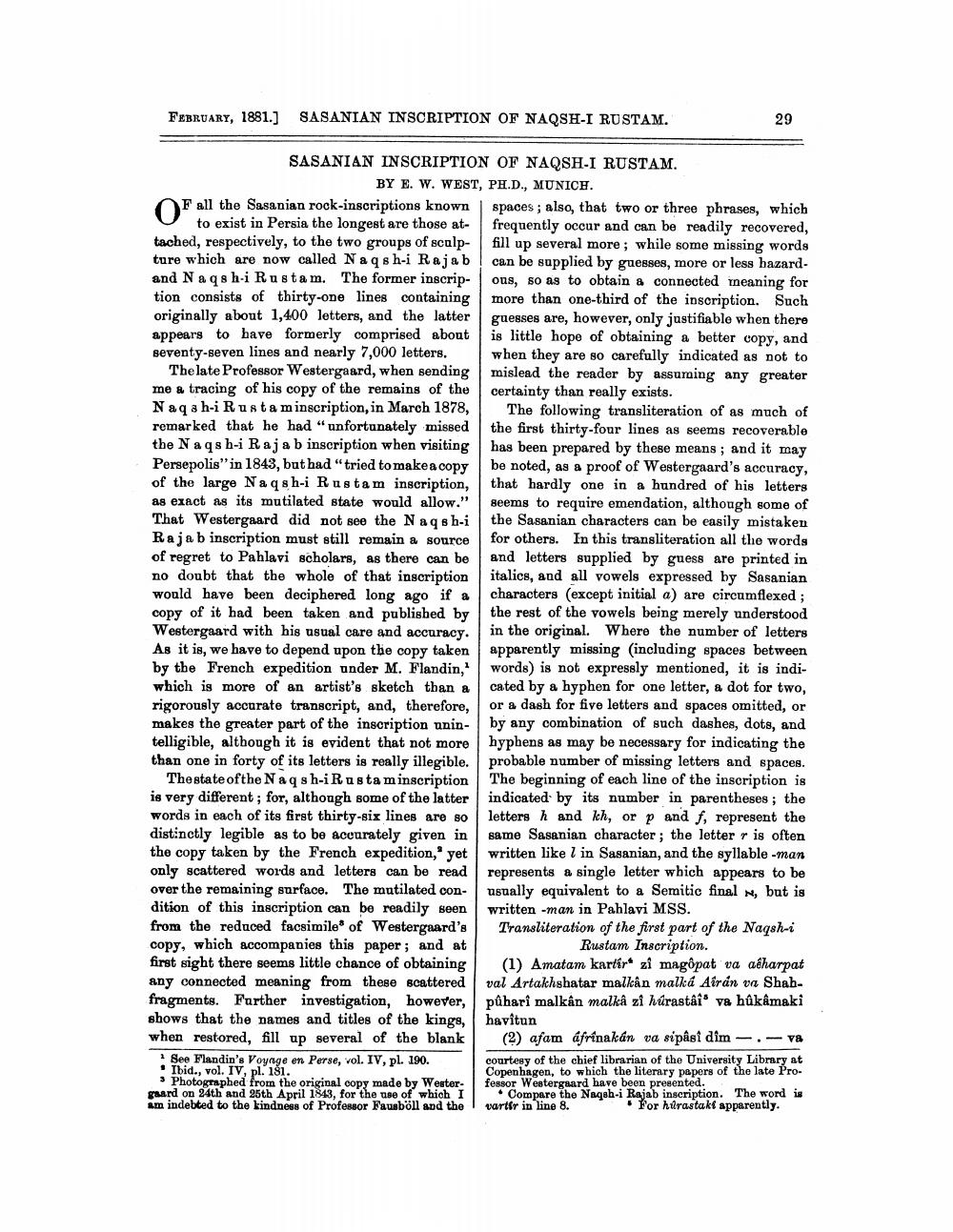________________
FEBRUARY, 1881.] SASANIAN INSCRIPTION OF NAQSH-I RUSTAM.
SASANIAN INSCRIPTION OF NAQSH-I RUSTAM. BY E. W. WEST, PH.D., MUNICH.
OF all the Sasanian rock-inscriptions known
to exist in Persia the longest are those attached, respectively, to the two groups of scalpture which are now called Naqsh-i Rajab and Naqsh-i Rustam. The former inscription consists of thirty-one lines containing originally about 1,400 letters, and the latter appears to have formerly comprised about seventy-seven lines and nearly 7,000 letters.
The late Professor Westergaard, when sending me a tracing of his copy of the remains of the Naqah-i Rusta minscription, in March 1878, remarked that he had "unfortunately missed the Naqsh-i Raj a b inscription when visiting Persepolis" in 1843, but had "tried to make a copy of the large Naqsh-i Rustam inscription, as exact as its mutilated state would allow." That Westergaard did not see the Naqsh-i Rajab inscription must still remain a source of regret to Pahlavi scholars, as there can be no doubt that the whole of that inscription would have been deciphered long ago if a copy of it had been taken and published by Westergaard with his usual care and accuracy. As it is, we have to depend upon the copy taken by the French expedition under M. Flandin,' which is more of an artist's sketch than a rigorously accurate transcript, and, therefore, makes the greater part of the inscription unintelligible, although it is evident that not more than one in forty of its letters is really illegible.
The state of the Naqsh-i Rustam inscription is very different; for, although some of the latter words in each of its first thirty-six lines are so distinctly legible as to be accurately given in the copy taken by the French expedition, yet only scattered words and letters can be read over the remaining surface. The mutilated condition of this inscription can be readily seen from the reduced facsimile" of Westergaard's copy, which accompanies this paper; and at first sight there seems little chance of obtaining any connected meaning from these scattered fragments. Further investigation, however, shows that the names and titles of the kings, when restored, fill up several of the blank
See Flandin's Voyage en Perse, vol. IV, pl. 190. Ibid., vol. IV, pl. 181.
Photographed from the original copy made by Westergaard on 24th and 25th April 1843, for the use of which I am indebted to the kindness of Professor Fausböll and the
29
spaces; also, that two or three phrases, which frequently occur and can be readily recovered, fill up several more; while some missing words can be supplied by guesses, more or less hazardous, so as to obtain a connected meaning for more than one-third of the inscription. Such guesses are, however, only justifiable when there is little hope of obtaining a better copy, and when they are so carefully indicated as not to mislead the reader by assuming any greater certainty than really exists.
The following transliteration of as much of the first thirty-four lines as seems recoverable has been prepared by these means; and it may be noted, as a proof of Westergaard's accuracy, that hardly one in a hundred of his letters seems to require emendation, although some of the Sasanian characters can be easily mistaken for others. In this transliteration all the words and letters supplied by guess are printed in italics, and all vowels expressed by Sasanian characters (except initial a) are circumflexed; the rest of the vowels being merely understood in the original. Where the number of letters apparently missing (including spaces between words) is not expressly mentioned, it is indicated by a hyphen for one letter, a dot for two, or a dash for five letters and spaces omitted, or by any combination of such dashes, dots, and hyphens as may be necessary for indicating the probable number of missing letters and spaces. The beginning of each line of the inscription is indicated by its number in parentheses; the letters h and kh, or p and f, represent the same Sasanian character; the letter r is often written like 7 in Sasanian, and the syllable -man represents a single letter which appears to be usually equivalent to a Semitic final, but is written -man in Pahlavi MSS.
Transliteration of the first part of the Naqsh-i Rustam Inscription.
(1) Amatam kartir* zî magôpat va acharpat val Artakhshatar malkân malká Airán va Shahpûhari malkân malkâ zî húrastai va hûkâmaki havitun
(2) afam áfrinakán va sipasi dim-.- va courtesy of the chief librarian of the University Library at Copenhagen, to which the literary papers of the late Professor Westergaard have been presented.
Compare the Naqsh-i Rajab inscription. The word is vartir in line 8. For húrastakt apparently.




